Upper Extremity Muscles
Objective 10.10
10.10.1 Give the origin, insertion, and action of the major muscles of the upper extremity.
10.10.2 Identify these muscles on a picture or image.
Upper Extremity
Rotator Cuff
The proximal part (glenoid) of the shoulder joint is formed by the scapula and clavicle. The head of the humerus fits into the glenoid. The rotator cuff which holds the glenoid and humerus together is formed by four muscles: supraspinatus, infraspinatus, teres minor, and subscapularis. These muscles from a cuff around the shoulder joint (it’s not a cup). Their main goal is to provide glenohumeral (shoulder) joint stability. However, they do have individual actions which we will explore here. You will commonly hear about these muscles being injured.
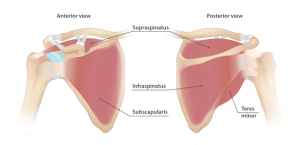

Deltoid
The deltoid is a large shoulder muscle. It is a common site for injections.
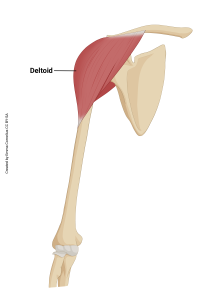

Serratus Anterior
The serratus anterior is a muscle that runs from your ribs to your shoulder blade. It is an important muscle to help move your scapula (shoulder blade) as you raise your arm.
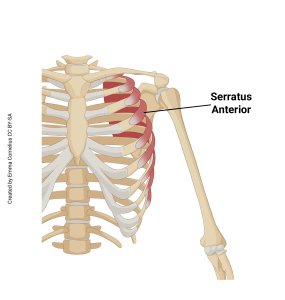

Pectoralis Major
The pectoralis major is a large muscle on the chest wall. It is the largest muscle in the pectoral region, hence pectoralis major. We do have a pectoralis minor but we will not study it in this course.
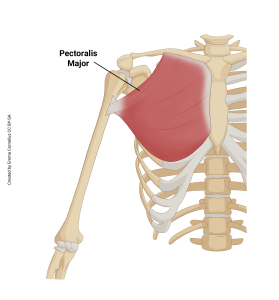

Latissimus Dorsi
The latissimus dorsi are often called the ‘lats’. You have probably seen a lat pull-down machine at the gym.
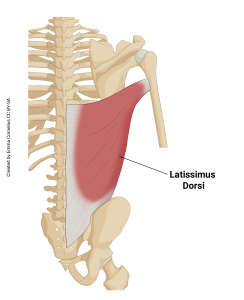

Triceps Brachii
Triceps refers to three origins. Brachii refers to the arm (brachium).
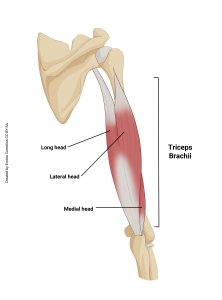

Biceps Brachii
Biceps refers to two origins. Brachii refers to the arm (brachium). The biceps get a lot of glory when doing bicep curls but this muscle is not your strongest elbow flexor (cliffhanger…).
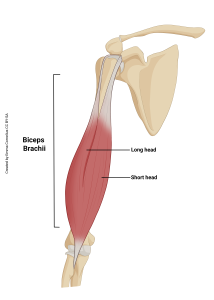

Brachialis
The brachialis is your strongest elbow flexor. You didn’t have to wait long to get the answer to which muscle is the strongest elbow flexor (cliffhanger from biceps brachii). This muscle lies underneath the biceps brachii, so you don’t see it much from the surface, and therefore, it doesn’t get much glory.
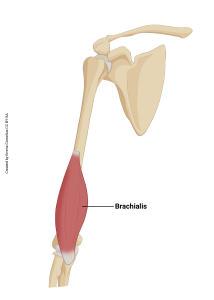

Brachioradialis
The brachioradialis is named for its attachments. It originates on the brachium (arm) and inserts on the radius.
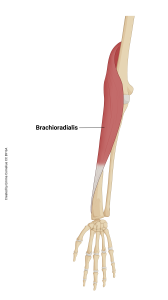

Wrist Flexors
There are multiple muscles, which we will group together, that cause flexion at the wrist. We are grouping them for simplicity but you should understand that these are multiple, separate muscles with slightly varying origin and insertion.
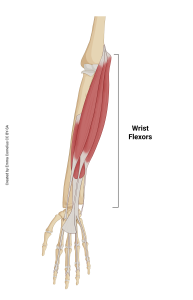

Wrist Extensors
Just like the wrist flexors, we have multiple muscles that cause extension at the wrist. Most of these share some common attachments and actions. We are grouping them for simplicity but you should understand that these are in reality separate muscles with slightly varying origin and insertion.
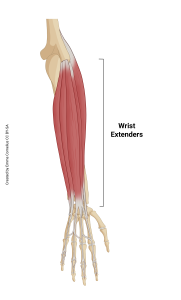

Media Attributions
- U10-038 Rotator_cuff_muscles.svg © Cornelius, Emma is licensed under a CC BY-SA (Attribution ShareAlike) license
- U10-039 rotator cuff origin insertion table © Bizzell, Lizz is licensed under a CC BY-SA (Attribution ShareAlike) license
- U10-040 deltoid © Cornelius, Emma is licensed under a CC BY-SA (Attribution ShareAlike) license
- U10-041 deltoid origin insertion table © Bizzell, Lizz is licensed under a CC BY-SA (Attribution ShareAlike) license
- U10-043 serratus anterior © Cornelius, Emma is licensed under a CC BY-SA (Attribution ShareAlike) license
- U10-042 serratus origin insertion table © Bizzell, Lizz is licensed under a CC BY-SA (Attribution ShareAlike) license
- U10-044 pectoralis major © Cornelius, Emma is licensed under a CC BY-SA (Attribution ShareAlike) license
- U10-045 pectoralis origin and insertion table © Bizzell, Lizz is licensed under a CC BY-SA (Attribution ShareAlike) license
- U10-046 latissimus dorsi © Cornelius, Emma is licensed under a CC BY-SA (Attribution ShareAlike) license
- U10-047 lats insertion and origin table © Bizzell, Lizz is licensed under a CC BY-SA (Attribution ShareAlike) license
- U10-048 triceps © Cornelius, Emma is licensed under a CC BY-SA (Attribution ShareAlike) license
- U10-049 triceps origin and insertion table © Bizzell, Lizz is licensed under a CC BY-SA (Attribution ShareAlike) license
- U10-050 biceps brachii © Cornelius, Emma is licensed under a CC BY-SA (Attribution ShareAlike) license
- U10-051 biceps origin and insertion table © Cornelius, Emma is licensed under a CC BY-SA (Attribution ShareAlike) license
- U10-052 brachialis © Cornelius, Emma is licensed under a CC BY-SA (Attribution ShareAlike) license
- U10-053 brachialis origin and insertion table © Bizzell, Lizz is licensed under a CC BY-SA (Attribution ShareAlike) license
- U10-054 brachioradialis © Cornelius, Emma is licensed under a CC BY-SA (Attribution ShareAlike) license
- U10-055 brachioradialis origin and insertion table © Bizzell, Lizz is licensed under a CC BY-SA (Attribution ShareAlike) license
- U10-056 wrist flexors © Cornelius, Emma is licensed under a CC BY-SA (Attribution ShareAlike) license
- U10-057 wrist flexors origin and insertion table © Bizzell, Lizz is licensed under a CC BY-SA (Attribution ShareAlike) license
- U10-058 wrist extenders © Cornelius, Emma is licensed under a CC BY-SA (Attribution ShareAlike) license
- U10-059 wrist extensors origin and insertion table © Bizzell, Lizz is licensed under a CC BY-SA (Attribution ShareAlike) license

